I reached the front door of my Warmshowers host, Ted.
I’d never used Warmshowers before, so I had absolutely no idea what to expect.
I wasn’t left in any doubt about whether I had found the correct house. There was a big blue plastic sign in the window with Ted’s name on it, advertising campaign for the state House.
My first thought was, ‘This guy is running for office, why the hell is he hosting the likes of me to come into his home and take time away from this?’
Hedy, Ted’s partner, answered the door and helped me get the bike into the garage. After living mostly in solitude since Fairbanks, being invited into someone’s home was a culture shock of sorts.
Hedy gave me a tour around the house, where the all important shower was, how to light the stove without setting the house on fire, which dog I could pet (Stella) and which might be a tad nervous (Lucky).
I briefly met Ted, who apologised that they had a dinner date with some friends and had to rush out.
Within 15 minutes of meeting me they left a complete stranger in their house.
Very trusting!
I had planned on staying just two nights and heading onwards after one day off, however they insisted I stay longer. ‘Okay one more night…’ ended up turning into 3 full days in Anchorage.
Ted and Hedy are both type A personalities who throw themselves into everything that they do: Ted would be on the phone to potential sponsors, while Hedy was powering away on social media, pushing the virtual Ted campaign forwards. Clearly the whole operation was a team effort.
Apparently the best time for canvassing is between midday and eight pm. Ted must really get his steps in because he was out every evening ‘doing doors’. He clearly believes in putting himself out there and making a human connection with potential voters. He wouldn’t even tell them which political party he represented unless they asked.
Hedy offered to drive me into town to get all my chores sorted. Since it was the weekend and she didn’t have to work, we could hang out in the evenings. Turns out Hedy and Ted both used to be teachers, like me.
Hedy is a big wine lover and I’ve never said no to a nice glass. By the time Ted got home I think we had got to know each other pretty well.
Hedy cooked up some salmon that Ted had caught last season. Salmon is both a luxury and a staple food in Alaska. Native populations relied upon salmon for their subsistence. Many still do. Both visitors and residents flock to the rivers in summer time when the salmon are running.
Alaska gets all five species of Pacific salmon: Sockeye (red), king (chinook), chub (dog), pink (humpy) and silver (coho).
Ted’s licence plate essentially read ‘sockeye’, so he clearly wasn’t immune to the state-wide salmon craze.
Unlike the Atlantic salmon that I’ve eaten in the past, this fillet was orangey-red rather than pinky-orange. The flavour was absolutely perfect with a slight sweetness to it. I was blown away by how good it was.
I ought to knock off this whole cycle touring game and grab a fishing rod!
The next two mornings Hedy and Ted took me on excursions into Chugach national park, a beautiful patch of mountains looming directly over Anchorage.
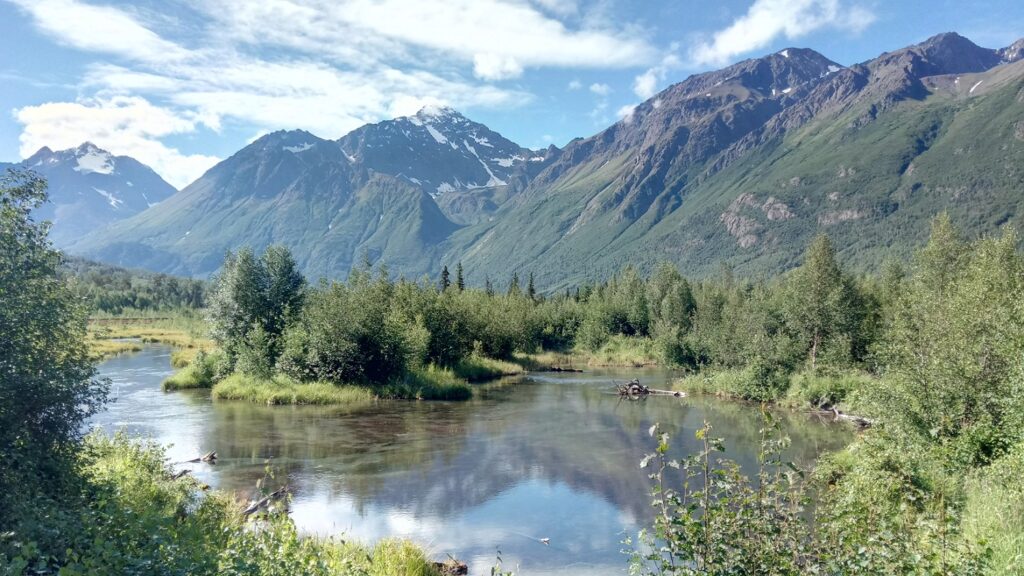

I received a crash course on all the fauna and flora of Alaska, including some very clear instructions regarding potential bear encounters.
Ted would head out in the evenings to knock on doors, leaving Hedy and I to work our way through the wine and have a good natter.
On the last day Ted took me out on his Yamaha Rhino ATV, essentially a quad bike with better creature comforts. This was supposed to be his practice run for a hunting trip in a few weeks.
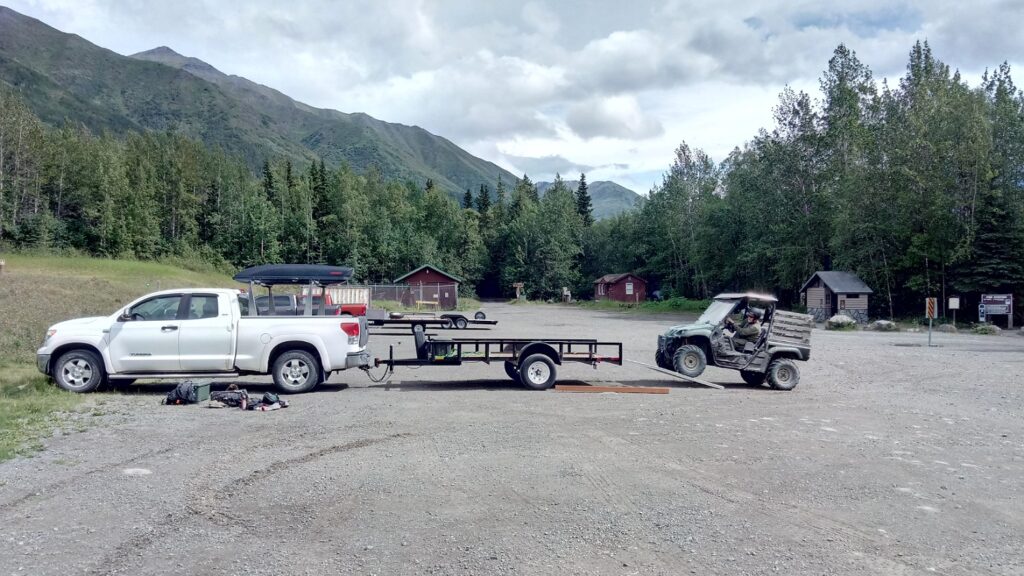
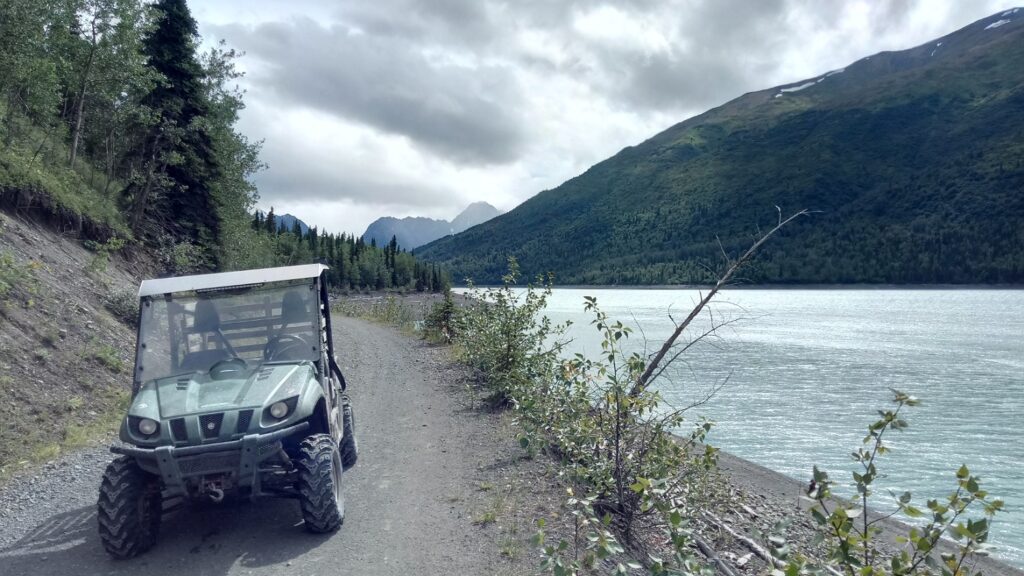
After four nights I knew it was time to go.
Time to get the wheels rolling and explore the next place.
Ted cooked us up a hearty breakfast of pancakes and bacon. Proper fuel for the pedals!
I didn’t feel like I had overstayed my welcome in the slightest, Ted and Hedy are just the most warm and open people I have ever met. I know who to call if I come back to Alaska!
I’ll do my best to pay this hospitality forward when it’s my turn as a Warmshowers host.
It’s just as well I took off as much time as I did, because the next leg of my journey required more careful planning than my previous approach of ‘just head South until it gets wet’.
If I wasn’t careful I would run myself into a very scenic dead end in Kenai Peninsula.
My original plan involved taking a ferry down to Juneau and then onwards to Skagway, pedalling into Canada via the Klondike Highway.
Unfortunately the next boat wasn’t for another ten days, and I didn’t feel like kicking around in Kenai for that long.
There was a boat from Whittier to Valdez leaving in just three days. Perfect for a brief potter around Kenai and then onwards.
Once in Valdez I would pedal North East to Tok and then across the Canadian border to Whitehorse. This was actually the route that Dan had recommended to me on the Dalton.
I spent until noon faffing around with all my bags and tidying up the guest room and bathrooms.
Just prior to me heading out Ted insisted he give me a practice run with some bear spray. He let me use an expired can to get the feel for how it all works.
10 metres feels awfully close to start spraying at a charging bear!
The ride out of Anchorage was largely uneventful. The city has a nice network of cycle trails from technical single-track to paved or gravel bike ways. I followed one to the coast path and headed South.
At Turnagain Heights I found evidence of the Good Friday Quake of March 27, 1964.
For four minutes a 9.2 Richter quake shook Anchorage. There was widespread destruction of property, with the central business district left 9ft lower than it had been.
Local tsunamis caused destruction at Kodiak Island, Valdez, as well as Whittier and Seward on Kenai.
Tsunamis claimed lives as far away as California and Oregon.
The largest landslide took place at Turnagain Heights, where the coastline had originally ended in bluffs.
184 acres of land sheared off and slid into the sea, taking 75 houses with it. Some moved as much as 600 feet from their previous locations.
I camped only about 30 miles out from my starting point. To go any further I would need to jump onto the main highway and I wasn’t feeling it that late in the day.
The next morning I packed up and braced myself for another busy highway.
What I got instead was a lovely coast road with fantastic views across Cook inlet to the mountains of Kenai peninsula.
The generous amount of shoulder at the side of the road kept me happily out of the flow of traffic while I took in the scenery.
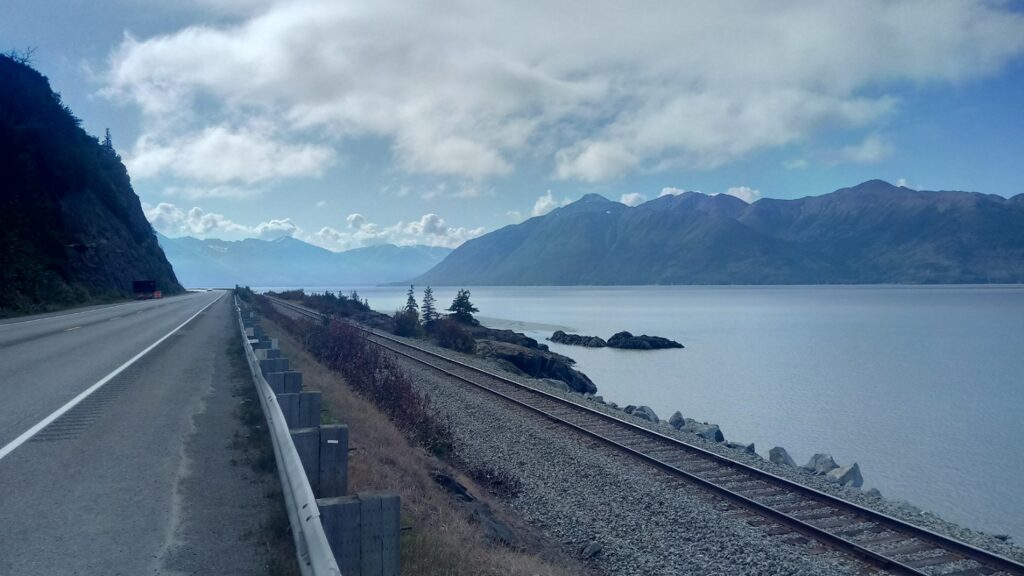
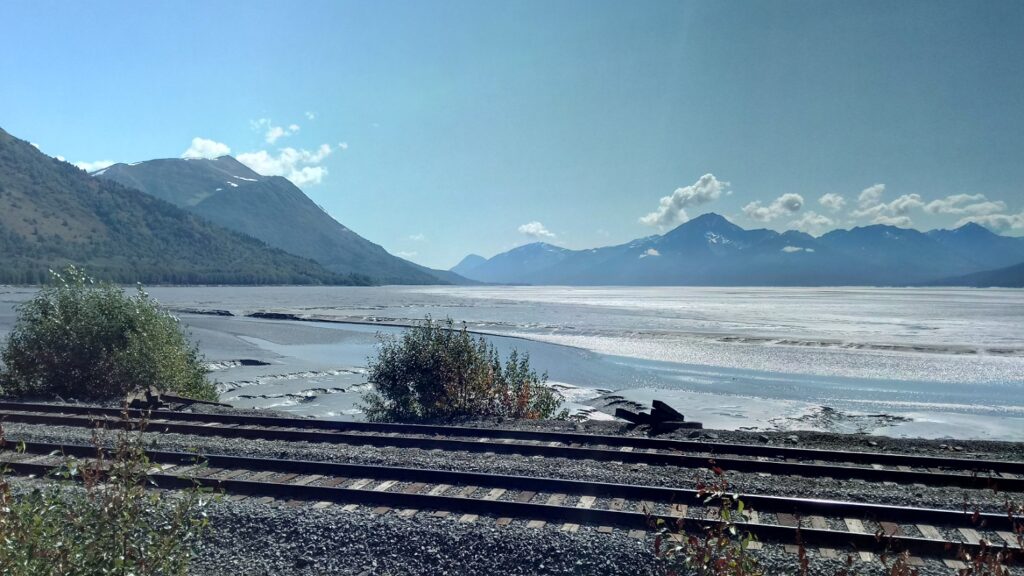
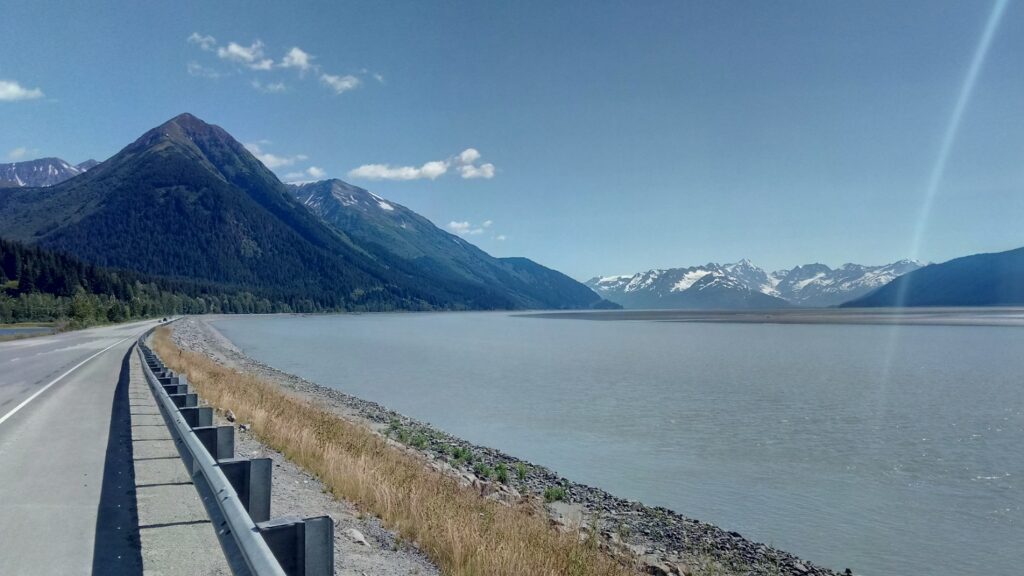
There was a separate bike lane halfway down to Kenai, however it had a rather annoying tendency to undulate.
This isn’t really a problem for your average day cyclist; you just keep your momentum going up the other side of a dip by mashing the pedals a bit harder.
It probably even added to the natural appeal of riding along the coast.
On my heavily laden touring bike, the weight is most noticeable when it comes to climbing.
Since I hope to be on the road for well over a year I really need to look after my knees.
I never force a high gear when the going gets tough, instead I drop down several and spin up slowly but surely.
Even a series of relatively brief climbs and descents can substantially slow me down.
After riding the bike path for about 10 minutes I got fed up and switched back to the shoulder of the highway.
Once on Kenai I hauled myself up to the top of Turnagain Pass.
I met a chap with a ‘US Army Veteran’ cap who told me about his time as a Huey helicopter mechanic from 1973 onwards. The class that graduated before him was the last to get sent to Vietnam. When I asked if he counted himself lucky or not he just said that things go the way they go.
He said he really enjoyed the Huey, but also had his fair share of unplanned interactions with the ground over his service. He showed me a long scar on his leg from a crash.
The next day I woke up at the crack of noon.
I usually quite enjoy my camp routine; It can be a meditation of sorts.
That all goes out the window if I’m uncomfortably cold, wet, hot or covered in biting insects.
Unfortunately this time I had the last two in abundance. Trousers and hoodie for the mosquitoes meant suffering in the heat.
I knew I had to just keep calm and do things carefully in their correct order, but I was working myself into a state.
I finally finished the process and was about to set off when I spotted that the rear tire was flat.
Whenever I get told a story of someone who cycled an epic distance the punchline always seems to be ‘… and they didn’t get a single puncture!’
Some people have all the sodding luck.
Luggage off. Toolkit out. Wheel off. Faff around trying to find puncture. Give up. Put new tube in. Reassemble.
By the time I got pedalling I just made a beeline for Whittier, enjoying the mountains along the way.
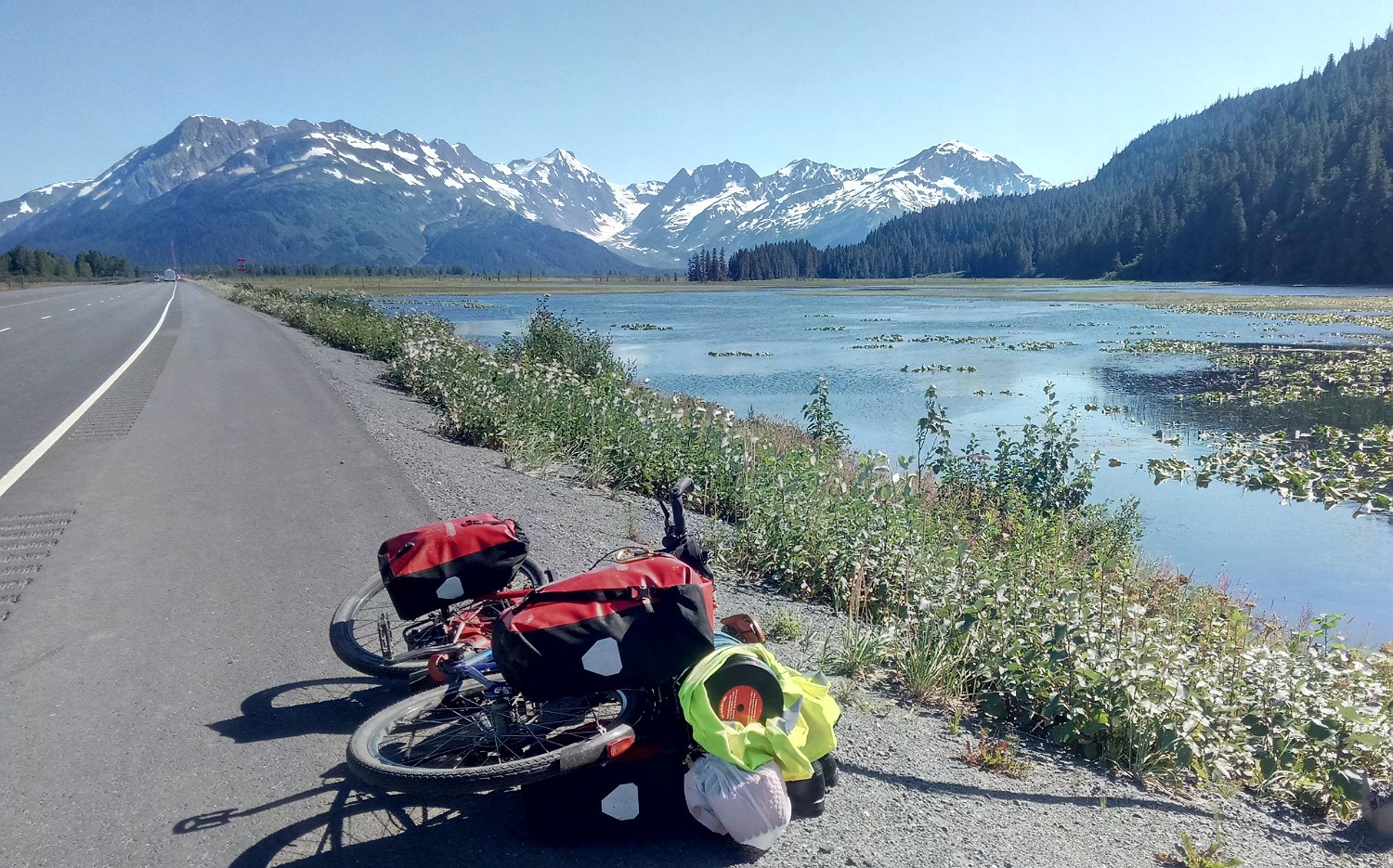
The port is isolated from the rest of the peninsula by mountains.
Portage glacier feeds into Portage lake. Presumably they take their name from the poor souls who had to haul their boats over the mountain pass (Portage pass, of course) to access Whittier.
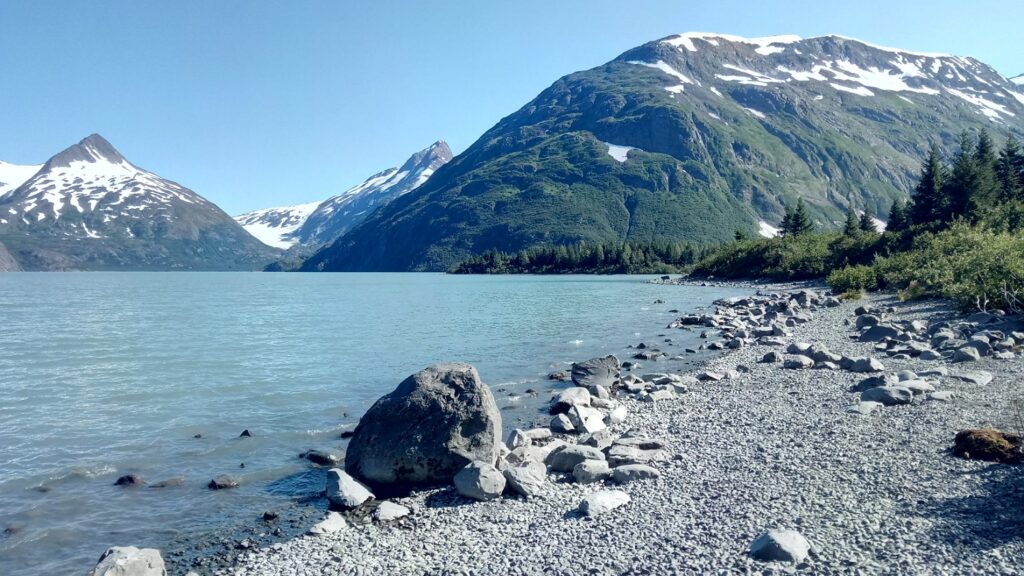
Nowadays there is a 2.5 mile tunnel which goes directly through the mountainside. Unfortunately it is only one car wide, so opposite traffic must take turns to roll through at pre-arranged time slots.
At the centre of the road is a railway and everyone has to wait if a train is going through.
No cyclists or pedestrians allowed.
Knowing this in advance, I had decided to rely upon hitching a ride.
I’d never tried hitchhiking before, but if I can’t stop for a sarnie without getting asked if I need help, surely this would be a doddle?
The first few cars didn’t work out. Most of them couldn’t fit all my clobber in anyway.
I started limiting it to pick-up trucks and campervans.
One camper drove up. The father gave me an apologetic wave of his hand and a grimace, while his son next to him thought I was giving them the thumbs up and returned the gesture. Thanks for the moral support kid…
Rob eventually stopped and loaded all my stuff into the back of his pick-up. Turns out he was a fisherman in Whittier.
He had a bit of a sailing background too: he built his own 22 footer from a set of plans back in the 70’s and ended up sailing across the Atlantic to Ireland. Hooked by the experience, he continued as far as Norway, finding a spot on the crew of an old wooden sailing freighter.
He eventually settled in Alaska and learned to fly.
These days he’s a fisherman in the summer season and a casual bush pilot the rest of the year.
He had some outstanding photos on his phone of his plane sitting improbably upon various glaciers. The wilderness of Alaska really opens up to you if you can fly.
Apparently he also has had his share of mishaps and accidents. He didn’t show up to work one day, so his boss called around and directed a rescue helicopter to search for him. I asked if the rescue crew had anything snarky to say when they found him standing sheepishly beside his stranded aircraft. Apparently it was ‘we are leaving in 5 minutes, with or without you’.
I asked if he had considered putting floats on the aircraft for water landings, which seems to be a pretty common thing around here.
Since there wasn’t a float-plane dock anywhere nearby he would need the type which had retractable wheels.
Apparently if you don’t raise the wheels before trying to land on water they dig in and flip the plane over. He figured one day he would forget, so maybe not.
Rob gave me the grand tour of Whittier, which took all of about 15 minutes. The whole place is geared up for fishing and moving supplies to some of the other islands in the area.
Everybody in the town lives inside a single six story apartment building, since all other accommodation was destroyed in the 1964 quake.
Fishing is still very much a viable business in this patch; Just by working on his boat in summer season Rob can easily keep himself going for the rest of the year.
He told me that in ‘the good old days’ fishermen would zip off to Hawaii with their earnings once the season was done.
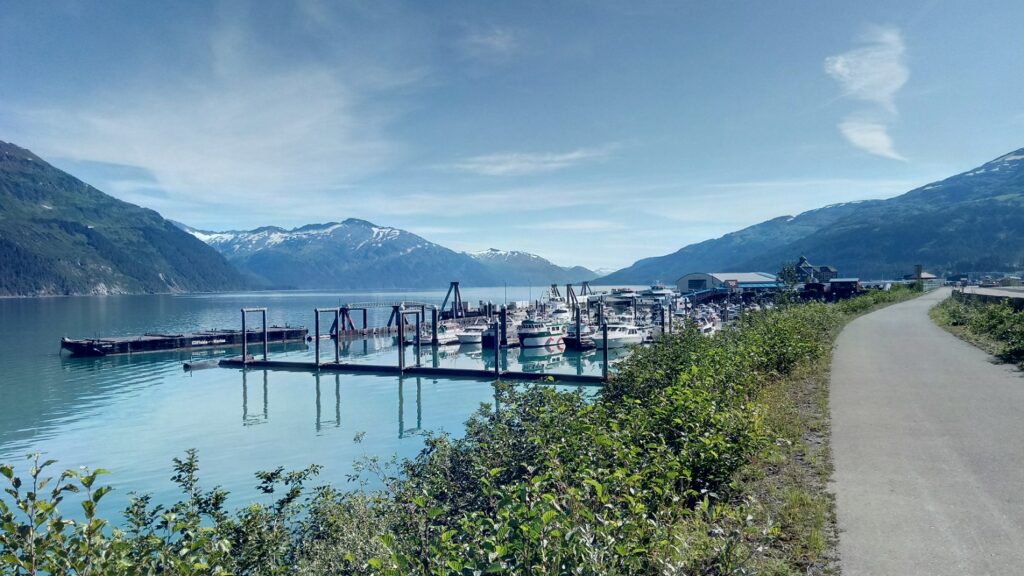
Those days are gone, but there were still quite a few expensive-looking pick-ups attached to equally nice boats in the yard.
Rob laughed and explained that with Gill Netting it doesn’t matter whether you have a 100,000 dollar boat or an old tub; they all use the same nets and therefore have an equal chance.
Tent down and off to the pub. Rob didn’t drink and had work to do on his boat.
The bar was a real local community affair. Kids were eating with their parents, a couple of fishermen were at the bar telling improbable stories and Fox News was blaring away in the corner.
The beer wasn’t cheap, but it had to come through the tunnel, which charges a ridiculous sum for commercial road traffic.
The next day I decided to get a bit of hiking in before catching my ferry to Valdez. Got a good vantage over the surrounding area from the top of Portage Pass.
The ferry from Whittier to Valdez was well worth it. The boat trip gets a great view of the mountainous coast east of the Kenai Peninsula.
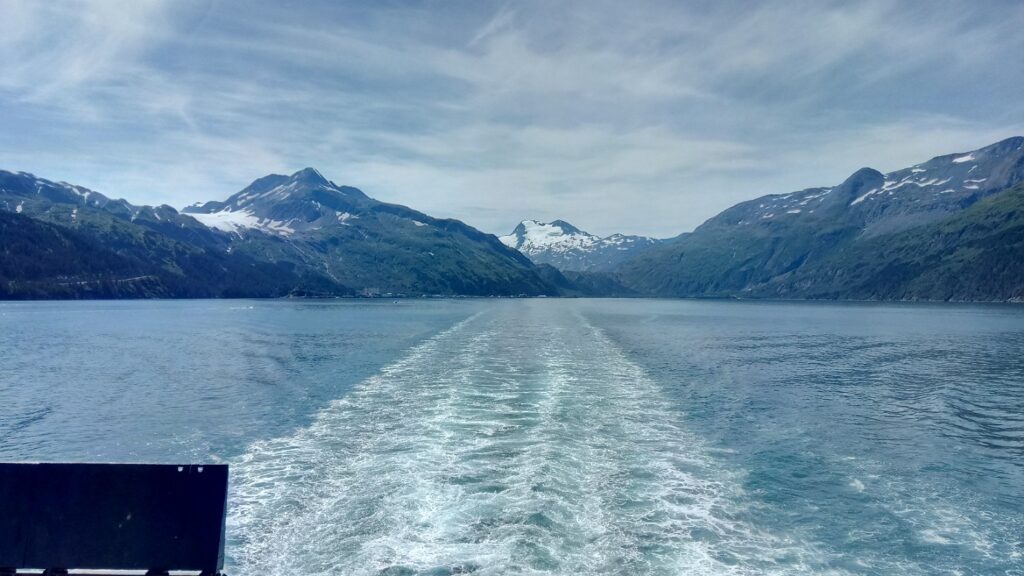
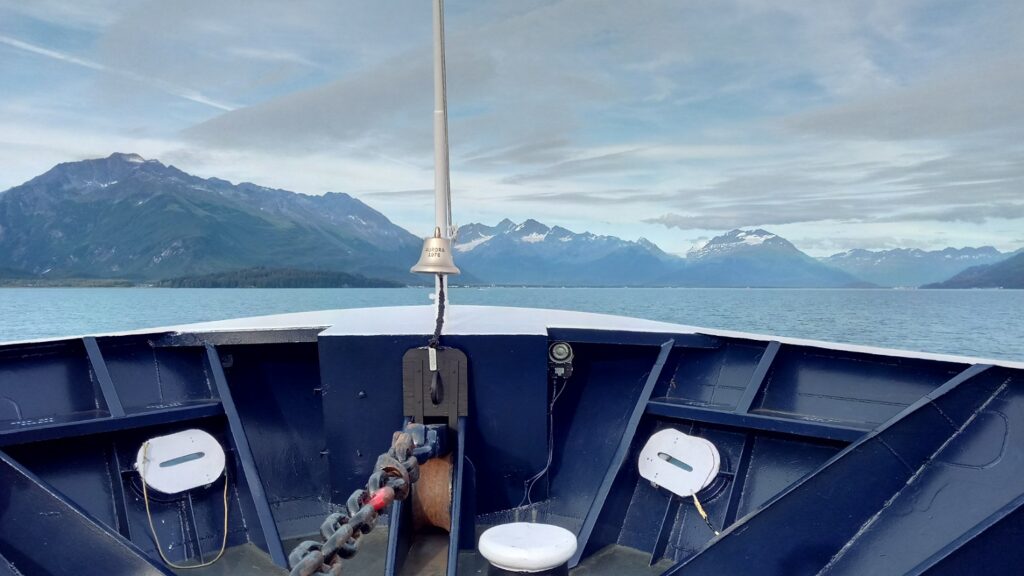
Valdez is a port town perched on a narrow stretch of flat land between the sea and the mountains.
I rode a little way out of town and plonked down my camp in a patch of long grass by the roadside.
The next day I woke up to rain and low level cloud. The sweeping views of the day before were replaced with a low lying murky drizzle.
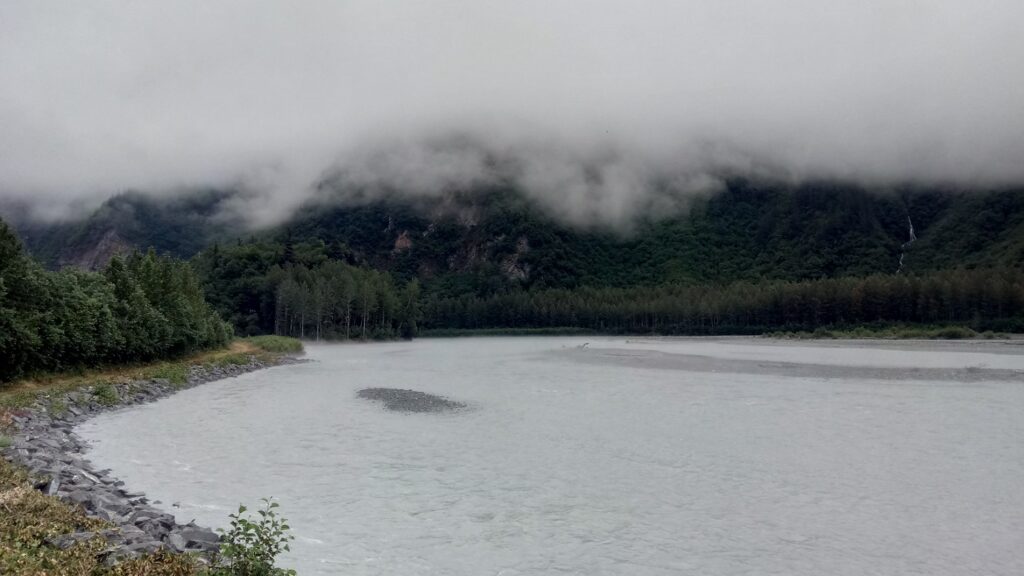
Given my diminished experience of Denali National Park due to similar low level clouds, I wasn’t holding out much hope for a scenic ride on this leg.
After a few miles I reached Keystone Canyon, which turned out to be a real treat.
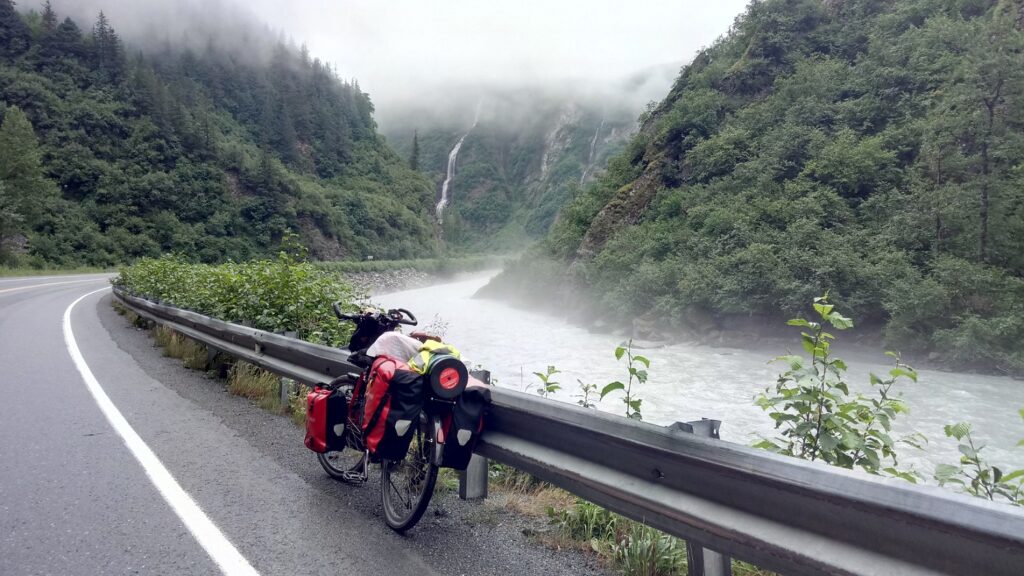
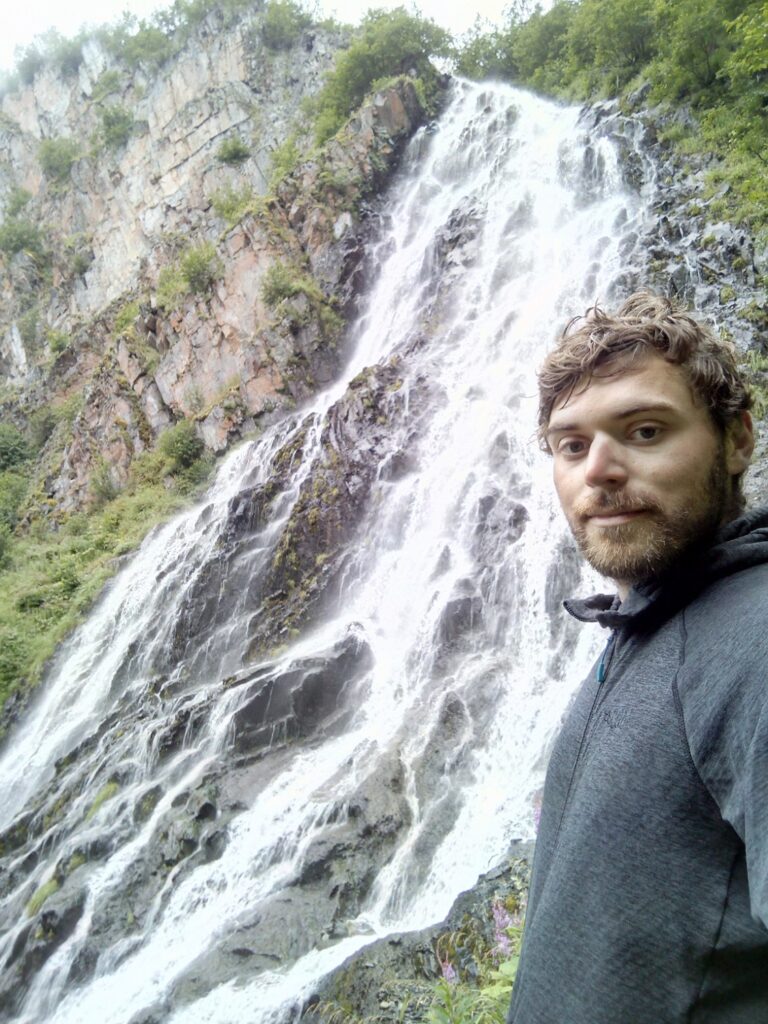
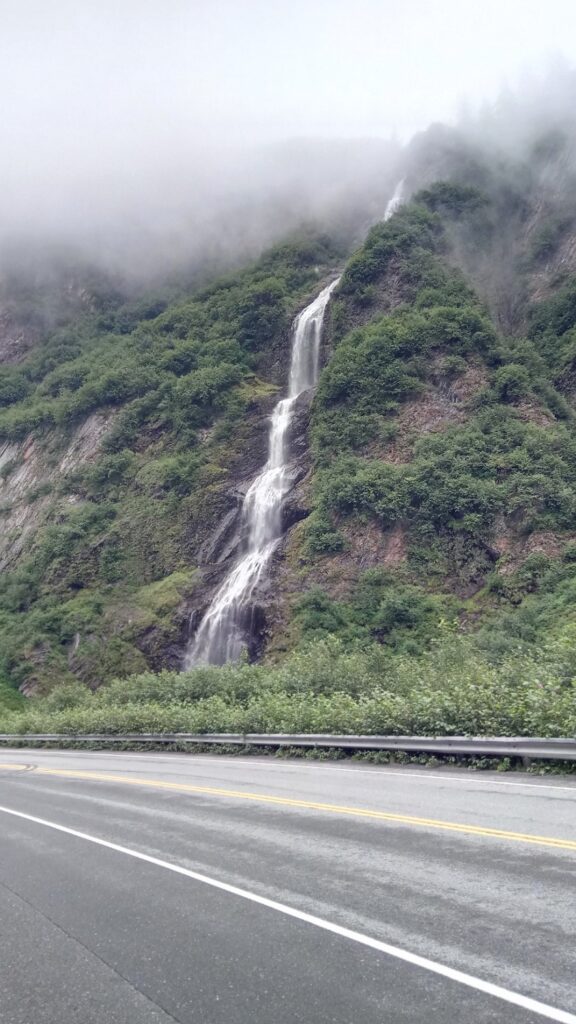
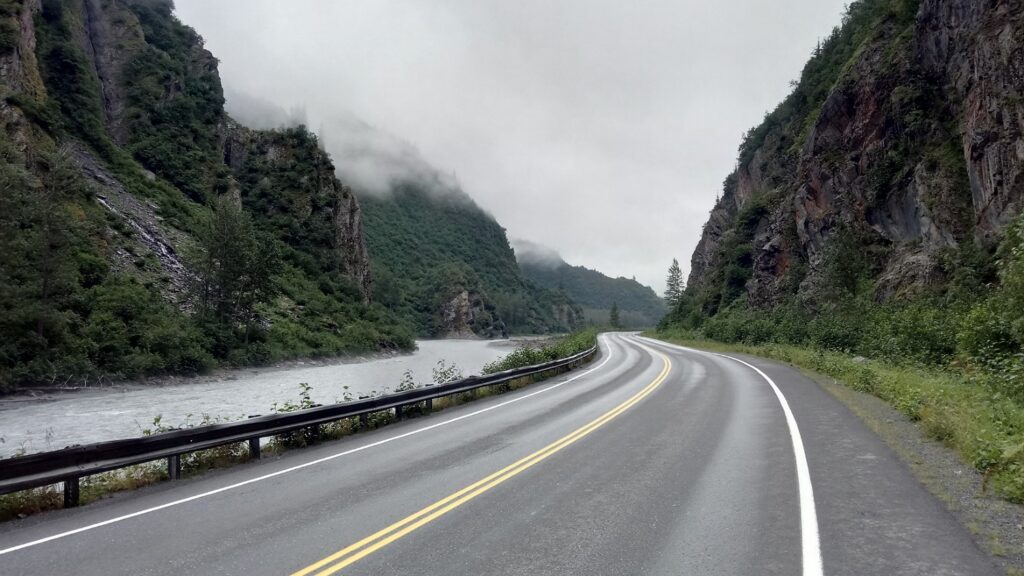
After lingering as long as I could it was time to move on.
Leaving the canyon, the road began to gradually climb.
I was in for a slow but steady haul up and over Thompson pass.
I couldn’t really see what was above me due to the cloud, and there wasn’t much use trying to scan the surrounding scenery for clues.
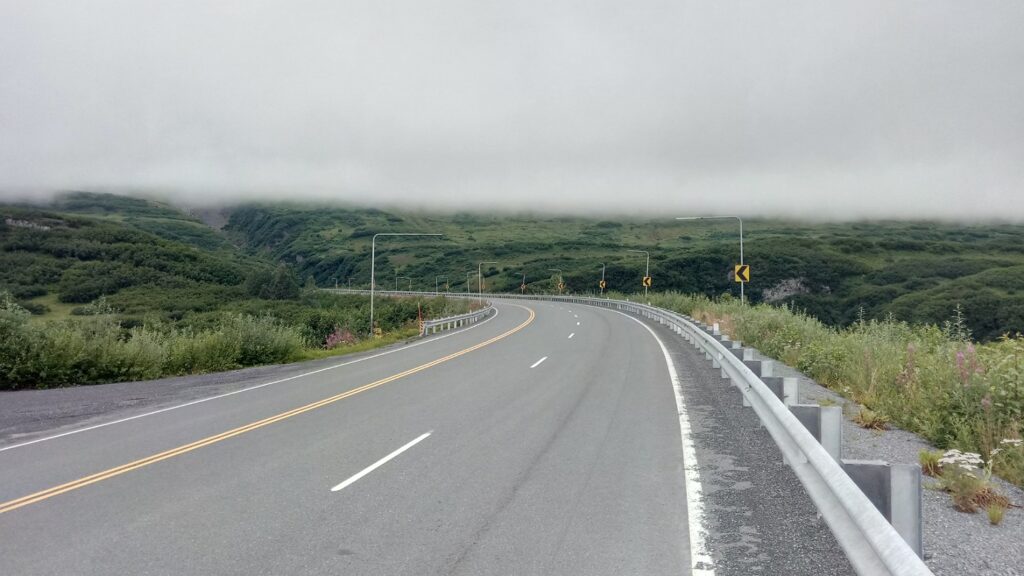
The road kept climbing and eventually I reached the cloud base. From then on visibility dropped dramatically, while cars and trucks continued to come flying past.
I think it took two jam tortillas to make the ascent, with a third going down the hatch in celebration at the top.
It got cold rolling down the reverse side, I must have put on pretty much all the clothes I had and tried to get out of the soup as quickly as possible.
I broke through the cloud base and saw snow capped peaks and a blue-white glacier snaking its way between two mountains.
Satisfied that I had earned my pedal points for the day, I switched back into tourist mode and made a side trip to check out Worthington Glacier.
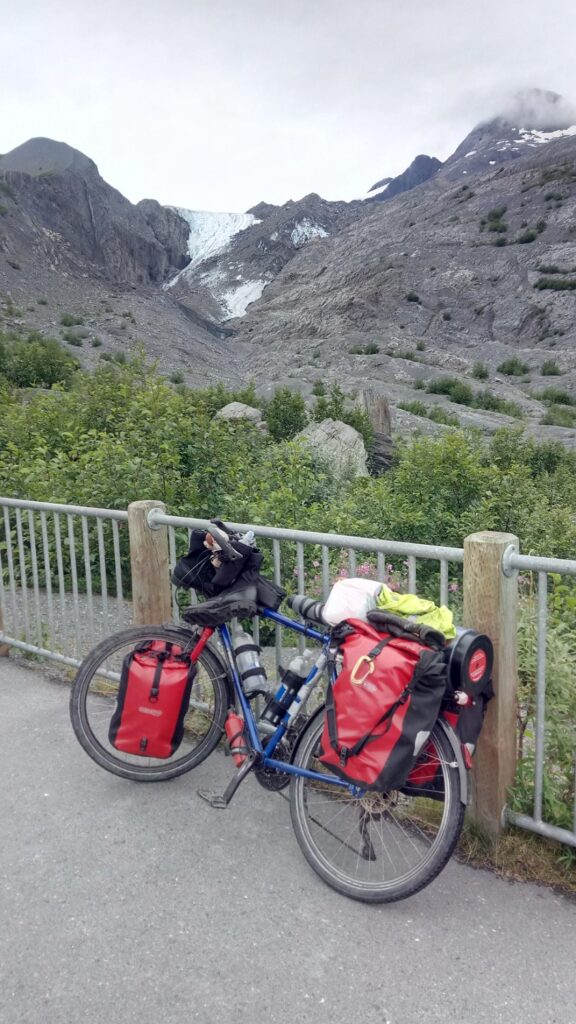
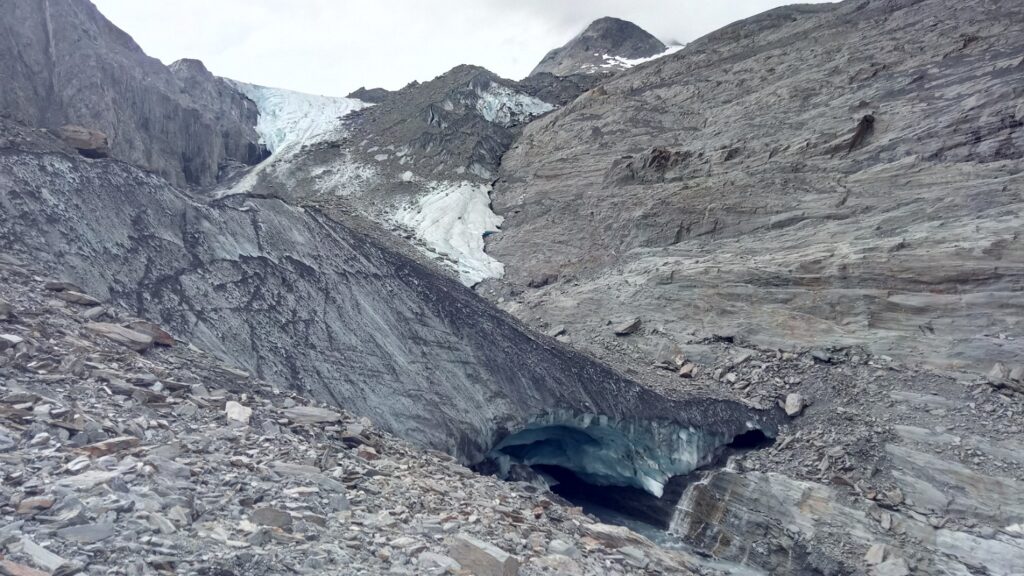
Normally I would never miss the opportunity to make the most of a descent, but given the fantastic panorama I decided to sod the mileage and just stay there for the night.
Probably my favourite camp of the trip so far.
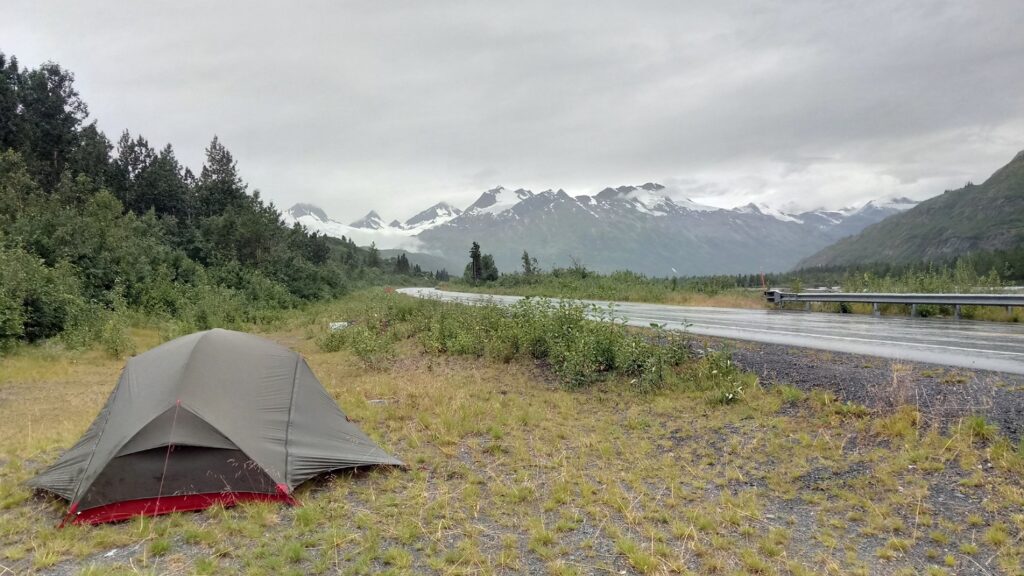
The next day it cleared up even more, with a few patches of blue sky visible.
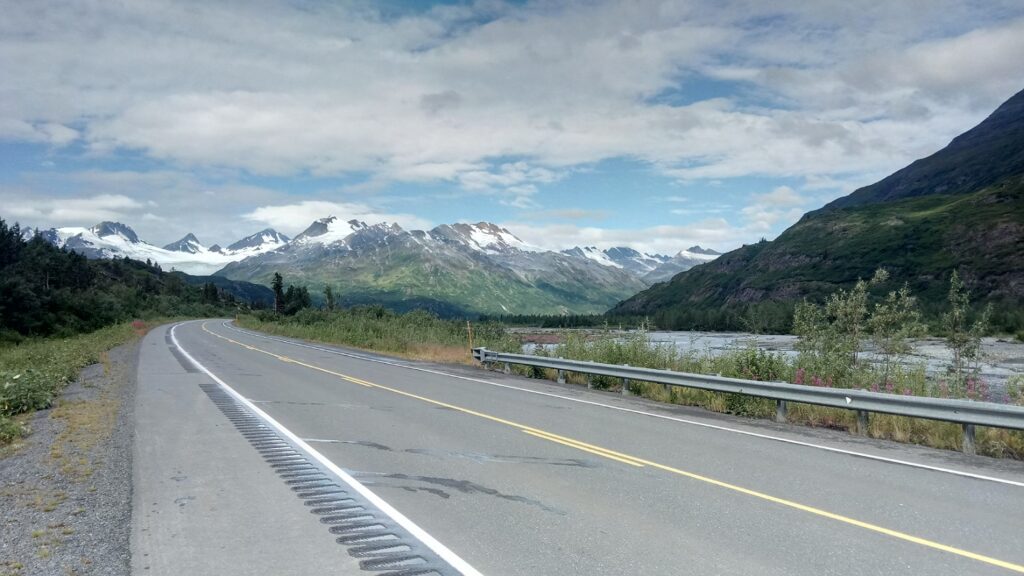
Having broken camp I enjoyed a long stretch of downhill.
After just a mile or so I saw something walking along the roadside in front of me. Some sort of quadruped. But it only had a stump for a tail?
I realised I was looking at a lynx and quickly grabbed my camera. As a predator, both of its eyes are in the front of its head, so I was able to creep up quietly behind it.
Unfortunately I wobbled off my line and noisily hit the rumble strip at the side of the road, which caused the lynx to immediately dash off into the bushes.
I continued rolling downhill.
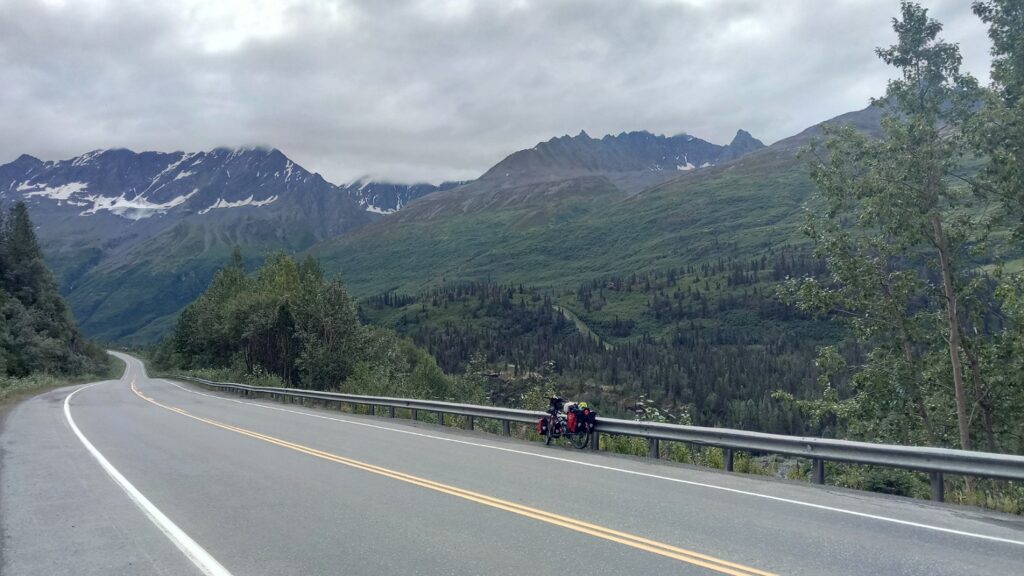

I really don’t want to take it for granted, but after a few hours I just get saturated. ‘Oh look, another breathtaking view… how lovely’.
A small Mom and pop grocery store was by the roadside and I decided to pull off to check it out. They had their own (enormous) greenhouse, which stocked their shelves with plenty of greens.
After living on carbs and tinned meat I can’t tell you how lovely that first orange was.
I grabbed a few bits and pieces and headed on my way.
More ups and downs and I had my fill of pedalling for the day.
Put the tent down on the roadside near Willow Lake, with views of distant Mt Drum and Mt Wrangell.
Now I was out of the mountains I decided to try my luck with the radio. Managed to get a Christian music channel from the local area.
They were doing a rewind of all the greatest Christian rock and pop hits of the last 30 years.
Actually not bad at all. Quite a few catchy numbers I found myself humming down the rest of the Richardson Highway.
The next day was pretty uneventful, just munching miles across gently undulating terrain.
I spotted a brown sign advertising a ‘Gold Rush Centennial Attraction’ and headed off on a side trip to Copper Centre.
In the midst of the Klondike Gold Rush, the Copper river region was targeted by prospectors hoping to make it rich.
From spring in 1898, over 4000 ‘stampeders’ hauled huge quantities of provisions and equipment on sleds over the mountains from Valdez.
Self sufficient, they had to bring everything they might need for an entire year.
In the museum I saw a list of items taken. Just the essentials worked out to about 1000 pounds per person. This would require each individual to make multiple trips over the mountains using sleds and boats.
Unlike the relatively civilised gradients I had enjoyed on the Richardson Hwy, the stampeders took the steepest, most direct route over Valdez Glacier, before descending the Klutina Glacier 78 miles to the Klutina River.
From here they took boats to the lower Klutina River, accessing the Copper River Valley.
70% of the boats capsized in the rapids with loss of life and material. This led to subsequent travellers laboriously hauling their boats slowly along the riverbanks rather than risking the current.
There was no gold to be found in Copper River Valley.
As the name suggests, copper had been extracted and traded for hundreds of years by the Native population.
Many of the prospectors staked copper claims, however only ‘Bonanza Valley’ ended up being commercially viable.
Scurvy rapidly spread due to dietary deficiencies in vitamin C, affecting 75% of the population of Copper Centre.
A hospital was opened, messages were sent back over the glaciers begging for medical support.
A mass panic spread as many residents believed that scurvy was a communicable disease.
By January 1899 the numbers of disillusioned prospectors heading back over the glaciers vastly outnumbered those still arriving.
Lt P.G. Lowe, an early explorer of the region, stated that ‘the country was advertised before it was tested’.
Copper centre ended up as a resupply point for prospectors heading deeper into the interior of Alaska.
Keeping with the historical theme I reached the wooden Gakona Roadhouse, built in 1904.
I tentatively asked the owner how much it would cost to camp, to which she answered it was free.
She pointed out the ‘Trapper’s Tavern’ next door as the other side of the business, providing hot food and beer.
She was definitely speaking my language.
The landlady told me her husband was a real beer lover, so despite the very rural location they had 15 different craft beers (and one cider) on tap. Obviously I was rubbing my hands together in glee.
Jerry, the barman, told me (several times) about how much he missed his home in Tennessee. He had been drawn by the attraction of The Last Frontier, but rapidly realised it wasn’t for him.
Apparently working 6 days a week behind the bar wasn’t enthusing him much either.
He also missed his Harley Davidson and told me about the extremely convoluted engine starting procedure on his Dad’s 1947 model, which ended with ‘… and if that doesn’t make it go, walk away. The bike will literally catch fire.’
Jerry really wanted to visit Belfast so that he could see the docks where the Titanic and her sister ships were built.
We were joined by Jerry’s mate, Tim, who works at the Department of Fish and Game.
Before he got his job Tim spent an entire year living off the land.
He would subsist by fishing, foraging and hunting.
Once he found out about my trip, and my diet of Spam and rice, he immediately rattled off a list of edible plants I could find in the wild.
He recommended giving mushrooms a wide berth, although he showed me one species which I couldn’t possibly mistake.
Tim is currently planning to travel down the Pan-American Highway in a van. He will probably still get there before me…
After several pints, we were all suitably intoxicated, so I said goodbye and walked in a meandering fashion back to my tent.
The next day, feeling fragile, I reluctantly pedalled onwards. The countryside turned back to boreal forest. Lots of black spruce and not a whole lot else.
Black spruce looks like a glorified stick with a few leaves attached to it, usually not over 10 metres tall. Most are less.
Despite its unassuming aesthetics it’s one of the hardiest trees on the planet: it’s shallow, but wide root system allows it to grow above permafrost.
In wilderness regions some examples can be a few hundred years old.
They have made up the bulk of the living scenery from The Brooks Range and all the way down to Anchorage.
Needless to say I didn’t dance a jig in excitement to be surrounded by them again.
I had my first bear encounter. I was keeping my head down as I pedalled along, so I didn’t see it until I pulled up alongside. The bear made whatever the bear equivalent of ‘Huh?!’ is, and went crashing through the undergrowth away from me. Probably off to tell its mates about its traumatic Chris encounter.
I didn’t really get a good look at it, but it appeared to be a black bear.
Getting near the end of the day I spotted the same mushrooms Tim had told me about the night before.
‘Check to make sure they leave a bluey-black mark on your fingers.’ Yep. Brilliant, into a ziplock bag and away.
I wasn’t entirely sure how I intended to work them into my planned meal of tinned chilli and rice, but I was sure I could manage something.
Got to my much anticipated camp and pulled out my food kit.
Everything was covered in bluey-black goo from the mushrooms. The offending articles themselves had turned into an unappetising mush, which found itself getting unceremoniously lobbed into the bushes.
After a sleep I was feeling much more interested in cycling and rapidly found myself pedalling through mountain scenes again.
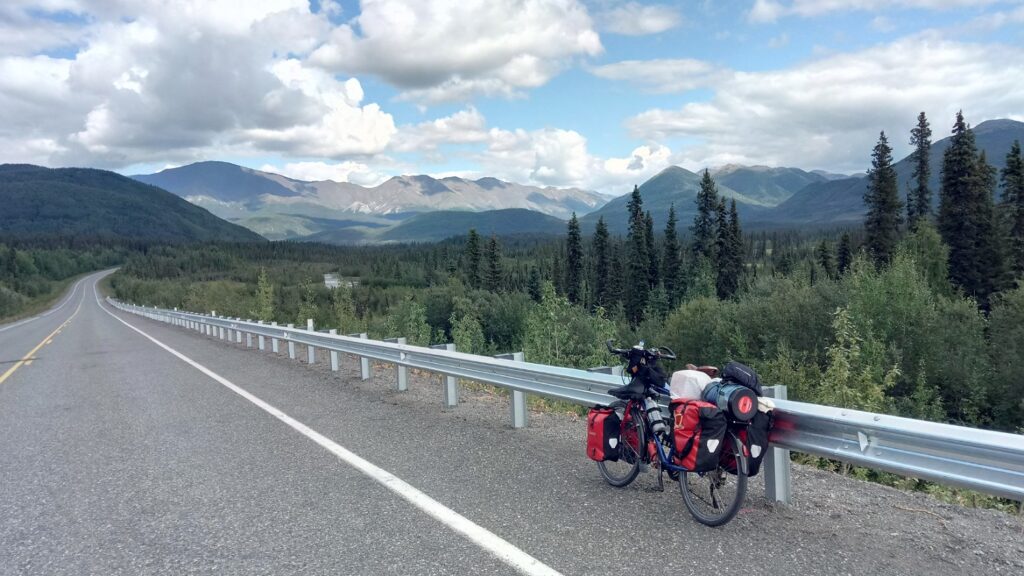
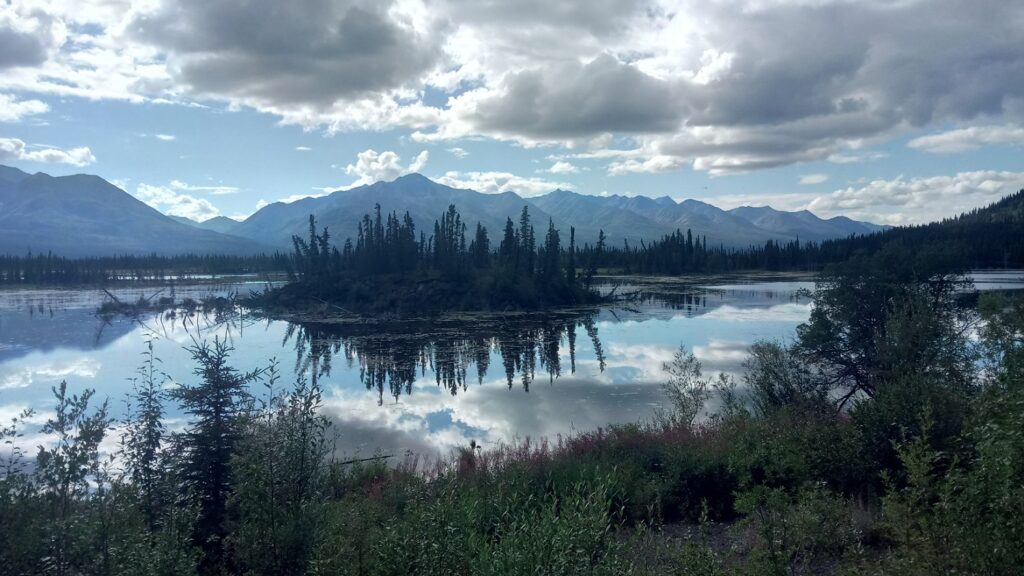
The great scenery continued the day after, taking me all the way to Tok.
I gratefully plonked my tent down and settled in for a couple days off the bike.
Feeling quite envious, but it’s under control, so we’ll not be joining you yet….interesting historical detail, one forgets how harsh a landscape it was for early settlers (and still is, clearly!). Love to hear about the people you are meeting, guess it helps to keep you going! Dave is impressed by the beard you are growing…. What do you do with the bike when you are camping out overnight? Do you hide it?! And is it also the case that camping too close to a river or stream might also get you a bit close and personal with any livestock that have the same idea? Just a thought. XX
Hi Julia and Dave!
There is so much water out here that hopefully I won’t get the whole water hole in the savanna situation where all the big furries come to visit! (Having said that I just met my first Grizzly yesterday… )
Bike I tend to use for my bottom two tent pegs. I figure the thing is such a lump that it will be better traction than a couple of pegs. If someone wants to try to take it in the night it should make the whole tent shake.
You can tell Dave that I’m considering just not trimming it for the next year and a half and going for the full hippy look. I just need to master the thousand yard stare when people ask where I’ve come from…
I feel like you two would make a better job of the wildlife side of things out here; this region gets a huge quantity of migratory birds. Lots of species I’ve never seen in my life and wouldn’t know where to start.
Great to hear from you!
Chris
We enjoyed sharing our home with you. We plan to follow your journey as you make your way to Argentina. We think of you often and are cheering for your success. 😁
Hey Hedy. Thanks again for all the hospitality! I hope to be back in Alaska as soon as possible 🙂
Hi Chris once again impressed with the scenery, would be stunning to fly over. I agree with the bear though, close encounters with the Chris kind are not to be sniffed at.
Keep peddling
Mark
…. Especially when I haven’t washed for over a week.
Definitely a once in a lifetime for the aviation inclined!